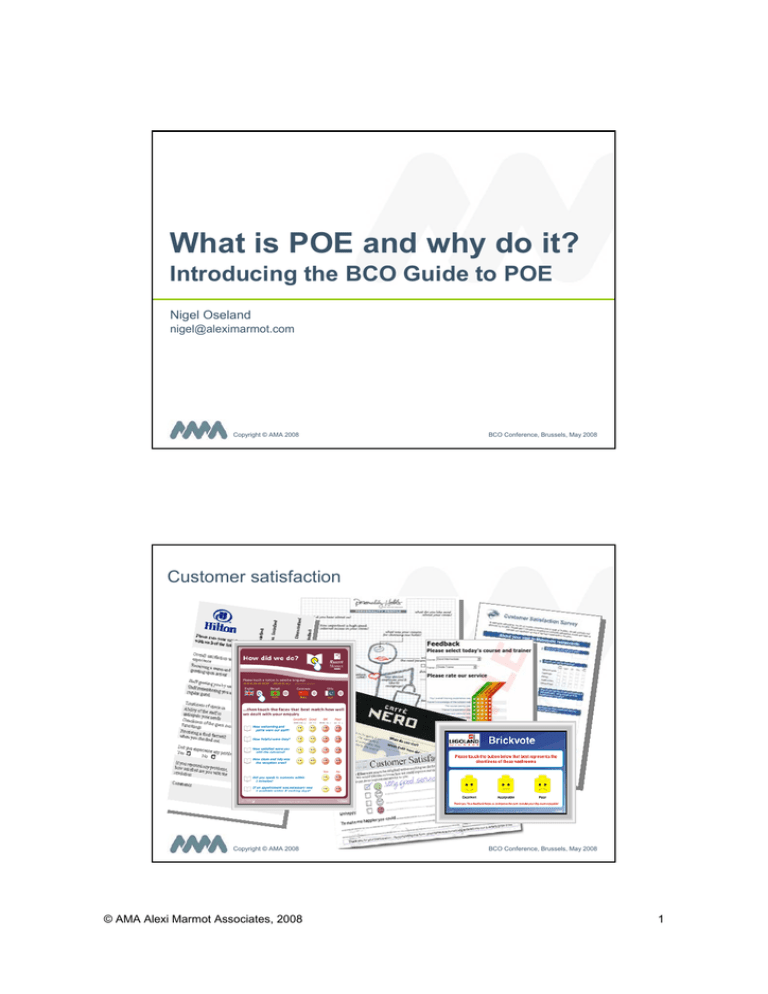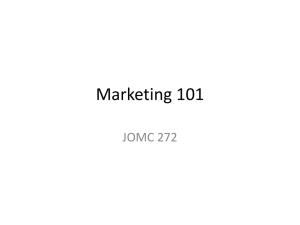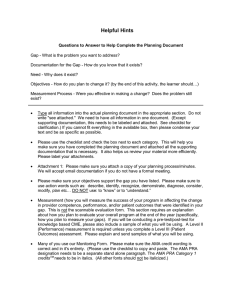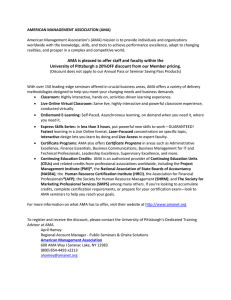BCO POE presentation - AMA Alexi Marmot Associates
advertisement

What is POE and why do it? Introducing the BCO Guide to POE Nigel Oseland nigel@aleximarmot.com Copyright © AMA 2008 BCO Conference, Brussels, May 2008 Customer satisfaction Copyright © AMA 2008 © AMA Alexi Marmot Associates, 2008 BCO Conference, Brussels, May 2008 1 BCO Guide to Post-Occupancy Evaluation • Raise awareness of the benefits of POE in design • Provide practical advice on conducting a POE • Foster sharing of feedback and lessons learned • Which of you have conducted a POE? • Which of you have used the guide? • Which of you intend to use the guide? Copyright © AMA 2008 BCO Conference, Brussels, May 2008 What is POE “evaluating buildings in a systematic and rigorous manner after they have been built and occupied for some time” “a building’s performance indicates how well it works to satisfy the client organisation’s goals and objectives, as well as the needs of individuals in that organisation” Aronoff Centre, Cincinnati “foam follows function” Wolfgang Preiser Copyright © AMA 2008 © AMA Alexi Marmot Associates, 2008 BCO Conference, Brussels, May 2008 2 Why POE • Measuring project success and value Copyright © AMA 2008 BCO Conference, Brussels, May 2008 Measure success – were the objectives met? What the Architect proposed … What the Engineer proposed … What the QS proposed … What the Client wanted … Courtesy of SHCA Copyright © AMA 2008 © AMA Alexi Marmot Associates, 2008 BCO Conference, Brussels, May 2008 3 Why POE • Measuring project success and value • Design feedback: • “without a feedback loop every building, to some extent is a prototype – spaces and systems put together in new ways, with potentially unpredictable outcomes” (Cooper) Copyright © AMA 2008 BCO Conference, Brussels, May 2008 Design feedback - learn from mistakes Copyright © AMA 2008 © AMA Alexi Marmot Associates, 2008 BCO Conference, Brussels, May 2008 4 Why POE • Measuring project success and value • Design feedback: • “without a feedback loop every building, to some extent is a prototype – spaces and systems put together in new ways, with potentially unpredictable outcomes” (Cooper) • Inform the design process and focus expenditure Copyright © AMA 2008 BCO Conference, Brussels, May 2008 Inform the design process & focus expenditure Copyright © AMA 2008 © AMA Alexi Marmot Associates, 2008 BCO Conference, Brussels, May 2008 5 Why POE • Measuring project success and value • Design feedback: • “without a feedback loop every building, to some extent is a prototype – spaces and systems put together in new ways, with potentially unpredictable outcomes” (Cooper) • Inform the design process and focus expenditure • Proactive building management: • “prevents minor problems developing into longer-term chronic irritants” (Bordass & Way) Copyright © AMA 2008 BCO Conference, Brussels, May 2008 Proactive building management Copyright © AMA 2008 © AMA Alexi Marmot Associates, 2008 BCO Conference, Brussels, May 2008 6 Why POE • Measuring project success and value • Design feedback: • “without a feedback loop every building, to some extent is a prototype – spaces and systems put together in new ways, with potentially unpredictable outcomes” (Cooper) • Inform the design process and focus expenditure • Proactive building management: • “prevents minor problems developing into longer-term chronic irritants” (Bordass & Way) • Change management and communications Copyright © AMA 2008 BCO Conference, Brussels, May 2008 Change management Copyright © AMA 2008 © AMA Alexi Marmot Associates, 2008 BCO Conference, Brussels, May 2008 7 What’s in a POE • Occupant feedback: • questionnaires, workshops, interviews • Expert panel review / walkthrough • Environmental conditions monitoring • Space analysis • Time utilisation studies • Cost analysis • Sustainability assessment • Technical & architectural reviews Copyright © AMA 2008 BCO Conference, Brussels, May 2008 Lessons learned 30 Importance Ranking 25 Important but Satisfied PC 20 Important and Dissatisfied Desk Space Vent People Noise Layout Winter Temp 15 Summer Temp 10 Email Privacy Chair Equip Noise Daylight 5 Quiet Space 0 0 10 20 30 40 50 60 Dissatisfaction (%) Based on 68 buildings and 7200 responses, OPN/SHCA Database Copyright © AMA 2008 © AMA Alexi Marmot Associates, 2008 BCO Conference, Brussels, May 2008 8 Visa - Satisfaction with facilities Chair 100 Security 80 Cleaning services Desk space & shape Storage space 60 Circulation space Mail/post services 40 20 Network & email Layout 0 Telephone system Meeting rooms Fax & copier Reading/quiet areas Printers & peripherals Informal meeting areas PC & software Video conferencing Restaurant etc Courtesy of SHCA Copyright © AMA 2008 Pre = 74% Post = 92% Lower quartile Upper quartile BCO Conference, Brussels, May 2008 Visa - Satisfaction with environmental conditions Temperature 100 Aesthetics Air movement 80 60 Glare Ventilation (fresh) 40 20 Daylight 0 Electric lighting Indoor air quality Equipment noise Privacy People noise External noise Courtesy of SHCA Copyright © AMA 2008 © AMA Alexi Marmot Associates, 2008 Pre = 74% Post = 92% Lower quartile Upper quartile BCO Conference, Brussels, May 2008 9 5 minute exercise - Barriers to POE • What do you consider to be the main barriers to POE? Copyright © AMA 2008 BCO Conference, Brussels, May 2008 Barriers to POE • Facilities Manager: • we haven’t received any complaints • “opening a can of worms” • Designer: Copyright © AMA 2008 © AMA Alexi Marmot Associates, 2008 BCO Conference, Brussels, May 2008 10 Designer barriers Stage M Feedback ... liability ... litigation … reputation … POE Copyright © AMA 2008 BCO Conference, Brussels, May 2008 Barriers to POE • Facilities Manager: • we haven’t received any complaints • “opening a can of worms” • Designer: • detrimental effect on reputation • liability for defects • Occupier: • why should we pay? • disruption to staff and HR sensitivity Copyright © AMA 2008 © AMA Alexi Marmot Associates, 2008 BCO Conference, Brussels, May 2008 11 Thank you Nigel Oseland nigel@aleximarmot.com Copyright © AMA 2008 © AMA Alexi Marmot Associates, 2008 BCO Conference, Brussels, May 2008 12



